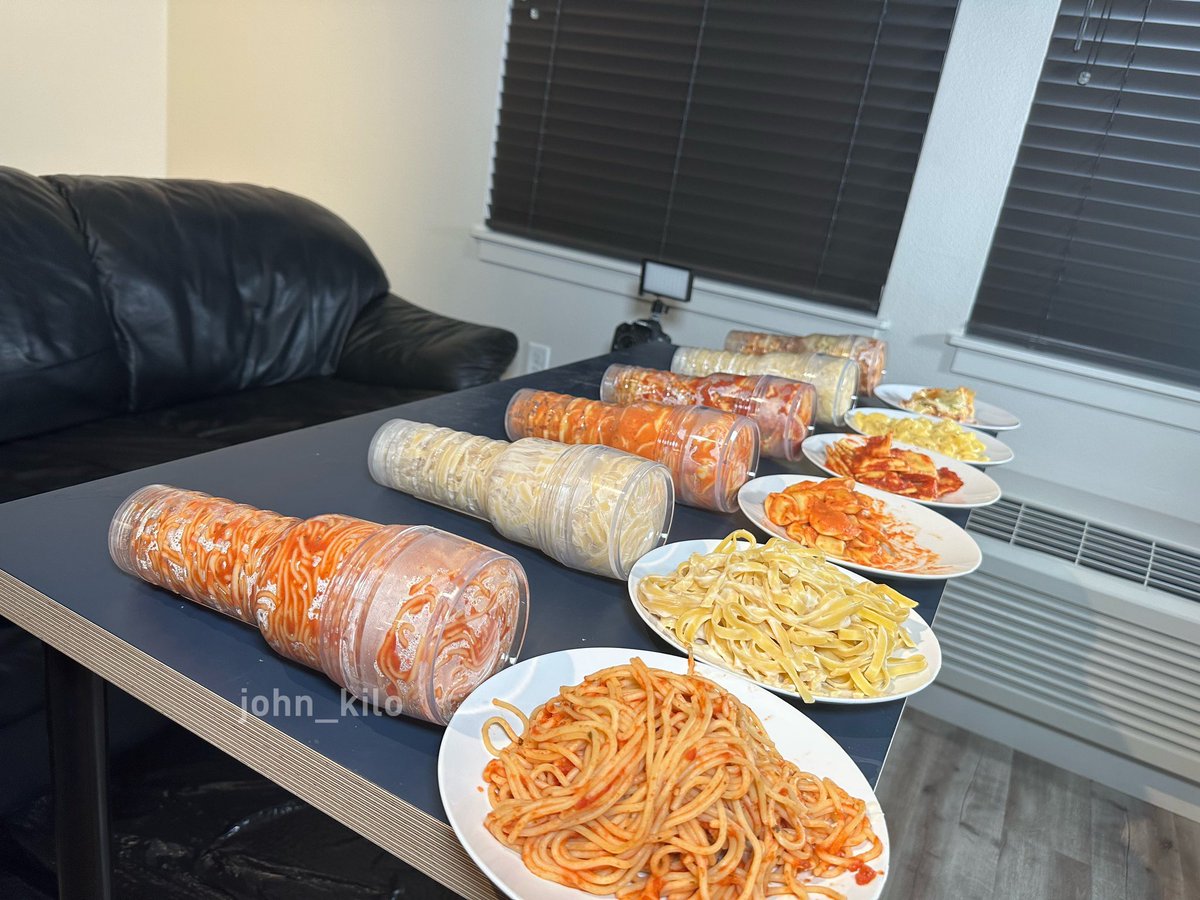Most "Fuckable" Pasta? 6 Dishes Tested: The Messy Results
Is it possible to find the "most fuckable" pasta? In a bizarre experiment that has captured the internet's attention, one individual embarked on a quest to determine which pasta shape offers the most...well, you get the idea.
The internet, a vast and often unpredictable landscape, has once again delivered a story that blends the absurd with the strangely compelling. At the heart of this particular narrative lies a series of videos featuring a man known as John Kilo, who has undertaken a highly unusual experiment. His objective? To determine which of six popular Italian-American pasta dishes is the "most fuckable." The dishes in question include spaghetti, fettuccine alfredo, cheese tortellini, ravioli, mac and cheese, and lasagna.
Kilo's methodology, as described in various online posts and videos, involved using fleshlights and the aforementioned pasta varieties. The videos, while censored to avoid explicit content, have nonetheless sparked a considerable amount of discussion and debate across social media platforms. The hashtag #mostfuckablepasta has gained traction, attracting a mix of amusement, bewilderment, and, inevitably, a degree of titillation.
The core premise, that of a man filling fleshlights with different pasta shapes to evaluate their "fuckability," is undeniably outlandish. Yet, the videos have tapped into a broader trend within online culture: a fascination with the unconventional, the taboo, and the overtly strange. Kilo, whether intentionally or not, has positioned himself at the intersection of food, sexuality, and performance art, albeit in a way that is both unconventional and, for some, potentially offensive. It's the kind of content that thrives on platforms like YouTube and social media, where boundaries are often blurred and shock value can drive engagement.
The man, identified online as John Kilo, isn't new to this type of content. He has a history of creating videos that experiment with food and sexuality, exploring the boundaries of what is considered acceptable and pushing the envelope of online content creation. His work, which has garnered a significant following, can be seen on various platforms. While his approach may be considered extreme by some, Kilo's work reflects a larger trend of content creators who are willing to explore niche interests and push the boundaries of what is deemed appropriate.
| Category | Details |
|---|---|
| Name | John Kilo |
| Occupation | Adult Video Creator, Food Experimenter |
| Known For | Creating videos involving food and sexuality, exploring unconventional themes |
| Notable Work | "Most Fuckable Pasta" series, experiments with various foods |
| Online Presence | Active on various adult video platforms and social media, search under John Kilo. |
| Associated with | The "awfuleverything" community, independent content creation |
| Residency | Portland, Oregon |
| Key Themes | Food fetish, unusual sexual explorations, shock value content |
| Website | ManyVids |
The experiment itself, regardless of its motivations, raises questions about the nature of online content and the evolution of social norms. It also shines a light on the audience's fascination with content that pushes boundaries, challenges expectations, and sparks conversation. Whether the focus is on the "most fuckable pasta," the "most fuckable cake," or the "most fuckable fruit," Kilo's videos have found a receptive audience.
The videos themselves, which have been described as "messy and surprising," and "censored but still NSFW," present a visual spectacle of pasta being inserted into fleshlights, apparently, a condom. The details of the experiment, though, are less important than the conversation it triggers. In a world where content creators constantly strive for attention, the "most fuckable pasta" experiment serves as a provocative statement, a reflection of the audience's interest in the unusual, and a commentary on the evolving landscape of online content creation. It is important to note that this content is not for all audiences.
Furthermore, the reaction to the videos, the discussions, the memes, and the general cultural dialogue surrounding it, underscore the potential of the internet as a space where unconventional ideas can thrive. John Kilo, through his unique content, has created a moment, perhaps even a sub-genre, of online content that encourages viewers to think, react, and engage. Whether the reaction is positive, negative, or simply perplexed, the videos have served their purpose. They have sparked a conversation, even if that conversation revolves around the unorthodox subject of "fuckable" pasta.
This brings us to the pasta dishes themselves, the subjects of this culinary experiment. The six dishesspaghetti, fettuccine alfredo, cheese tortellini, ravioli, mac and cheese, and lasagnarepresent a cross-section of popular Italian-American cuisine. The choice of these specific dishes offers a window into the creator's personal preferences, the culinary choices that resonate within American culture, and the potential to connect with a wider audience through familiar food references.
Each pasta shape, each sauce, and each combination of ingredients brings its own characteristics, both in terms of visual appearance and tactile qualities. The smooth strands of spaghetti, the creamy richness of fettuccine alfredo, the delicate shapes of tortellini, the stuffed pockets of ravioli, the comforting simplicity of mac and cheese, and the layered complexity of lasagnaeach dish presents unique attributes. These factors, however, are rendered irrelevant when evaluated by the experiment's criteria, which emphasizes texture, form, and, above all, the sensation within the fleshlight.
As the videos gained traction, they also inadvertently sparked some debate. Some people criticized the content as being in poor taste, exploitative, or simply strange. Others found it humorous, provocative, or even an interesting experiment in pushing the boundaries of online content. This division speaks to the inherent polarizing nature of art and media that challenge conventional standards. Kilo's approach, no matter how unconventional, serves to create a unique work that prompts discussion. These discussions can sometimes be more valuable than the content itself.
The broader context of this online trend is worth considering. The rise of platforms like YouTube and social media has given rise to new forms of content creation, and the audience is open to the unusual. This trend has helped pave the way for unconventional content to be created, shared, and consumed. This experimentation often involves blending different disciplines, such as food and sexuality. It also reflects the evolving landscape of online entertainment, where creators are constantly seeking new ways to engage audiences and establish themselves within a crowded digital space.
This example is further underscored by the existence of a community known as "awfuleverything." It highlights the diversity of online culture and the willingness of communities to engage with material that might be considered shocking or taboo by mainstream standards. This willingness reflects a deeper trend towards open discussion and exploration of all aspects of human experience. This can be the foundation of new forms of artistic expression, and it has created space for creative endeavors that may once have been deemed impossible.
Within this context, Kilo's content can be understood as a specific instance of the wider trend. He has engaged with a niche interest and created unique content, garnering attention, sparking conversation, and provoking a range of reactions. Regardless of the content's merit, it underscores how online culture can foster creativity, redefine norms, and provide a platform for ideas that are both unusual and unforgettable.
The popularity of the "most fuckable pasta" experiment has also drawn attention to the role of social media. Social media allows for such content to be shared widely. These platforms facilitate the dissemination of information and ideas, contributing to a more participatory and interactive media landscape. This has facilitated the rapid spread of Kilo's videos, making them a trending topic within a short period. This rapid dissemination helps shape contemporary conversations.
The question of which pasta is the "most fuckable" remains unanswered. However, John Kilo has succeeded in creating content that is, to put it mildly, intriguing, controversial, and reflective of the ever-changing world of online content creation. The experiment has captured the imagination of a segment of the internet audience and encouraged important discussions about online content, creativity, and the evolution of social norms. The impact extends far beyond the specific videos themselves, demonstrating that even something as simple as pasta can spark a discussion that resonates across the digital landscape.
The enduring nature of the internet ensures that this experiment, and the conversations that it has sparked, will continue to be available to anyone who seeks it. Therefore, the legacy of the "most fuckable pasta" may not be the answer to its central question, but rather, its ability to provoke thought, ignite debate, and challenge our assumptions about art, content creation, and the evolving complexities of our online world.
The story of "most fuckable pasta" also emphasizes the potential of the internet to democratize creativity. Traditional forms of art, media, and entertainment often rely on gatekeepers, but the digital realm provides creators with avenues to express their ideas without external limitations. Kilo's experiments, though unconventional, demonstrate that anybody can create content and reach audiences. This openness has helped democratize art and creativity and has led to innovative forms of expression.
One cannot overlook the business aspect of such a venture. While the primary motivation may be experimental or creative, the videos have also created opportunity for monetization. The creator's success in this regard underscores how innovative, niche content can provide opportunities. These videos, though unconventional, have shown the financial potential that lies within exploring unconventional ideas. This further reinforces the dynamic nature of the online space.


